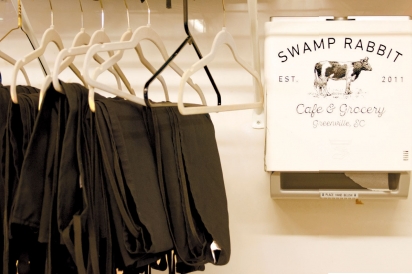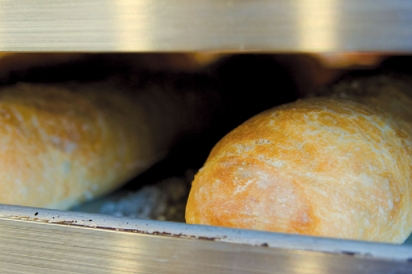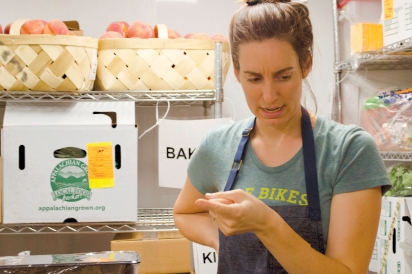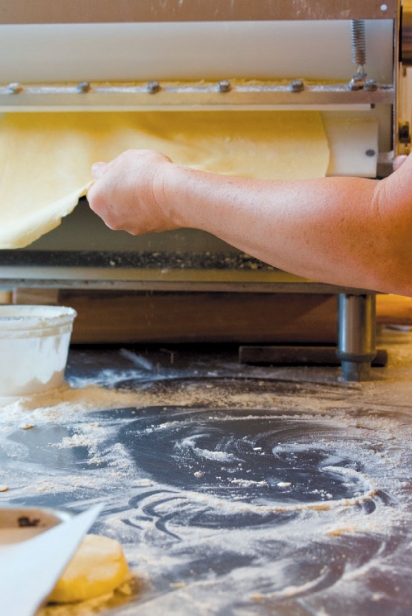A Day in The Life Of Swamp Rabbit Cafe's Kitchen Manager
Find out what happens behind-the scenes of one of the Upstate’s busiest local food markets by following Judi McRae, the Kitchen Manager at Swamp Rabbit Cafe and Grocery.
Bakers and prep staff swirl in waves of busy. Two huge rounds of risen dough sit on the marble counter. One of the bakers pulls off pieces, stretches them, and slips them onto baking trays to become the immensely popular Swamp Rabbit stecca bread. Another cuts rounds of dough and places them on a separate baking tray: the revered Swamp Rabbit scones.
Head Chef and kitchen manager Judi McRae—a graduate of the culinary program at Bob Jones University—has been in since 6:30 am. Every day she comes in early for quiet time, planning time, troubleshooting for the bakers. She compiles to-do lists, reviews what’s come in that the kitchen had planned for—and what hasn’t come in. Anything that’s missing requires an adjustment. No green beans? What could substitute? The coolers are covered with lists and notes, organized by day. The paste tomatoes expected this season haven’t come in, so Judi orders more heirloom slicers.
It’s now 8:30, and things are moving quickly. Baker Katie is beating butter—which is sandwiched between sheets of wax paper—with a rolling pin. This is the start of the flaky dough for croissants. Chocolate pies already sit cooling, waiting to be packaged. Iced cinnamon rolls sit on a tray, ready to be taken down the stairs into the café. Bakers have staggered schedules, Judi says, starting at 5 each morning, except for Saturdays, when someone comes in at 4:00 to make sure Swamp Rabbit’s market booths are filled with baked goodness.
A woman in sunglasses and a hat pokes her head around the corner of the doorway, peering into the kitchen. “So this is where the magic happens,” she says with a smile.
The kitchen area has changed quite a bit since the early days of Swamp Rabbit Café and Grocery. In the beginning, there were tables and an area where community members could teach classes and hold meetings. There was a room for childcare. Now, almost the entire upper floor is covered in kitchen appliances, counters, coolers, and storage areas, a testament to the café’s steady growth and expansion. They now have 105 employees, Judi says.
What I notice the most about Judi is her constant movement, from instructing to managing to organizing to doing. She walks 8 miles on a slow day, 14 on a busy one. While Judi is chopping okra that will be roasted for the Corn-ucopia and Okra Winfrey pizzas, Tanner is to her right, cutting up watermelon and getting ready to prepare the base for the café’s new watermelon lime frosé. Judi leaves what she’s doing to bring him the recipe sheet. “We’re making a 2X,” she says, as she walks him through the calculations to double the recipe. He juices limes, adds the juice and other ingredients to the watermelon, and starts to blend it. “Low and slow,” Judi advises.
Tanner mentions that his back is bothering him. Judi shows him how to stand to relieve some of the pressure, positioning her legs further apart in what she calls the giraffe stance. Now they don’t have to bend over so far to work on the table.
They begin chopping peaches, which go into smoothies and salads. In the last three years that Judi has been with the café, she’s worked to turn produce overages into products. Less than perfect fruit can be turned into a smoothie. Excess greens can go into the quiche or a chicken pot pie. “We give her a budget each week,” says Jac Oliver, co-owner with Mary Walsh of SRC&G. “She has to figure out how to produce everything within that budget.” Jac also remarks that Judi is “very creative and resourceful in using local food uncompromisingly at an affordable price point—not just when it’s convenient.”
There’s no doubt that Judi is in charge around here. If there’s a question about what to do, staff comes to her. When Sarah heads to clean the floor of a freezer, Judi explains to her about the temperature of the water she’ll be using and why that’s important. That freezer is known to staff as “Narnia,” since they have to exit one door and enter another to get to it, walking past the back entrance to the cycle shop that still squeezes into a space on the upper floor.
It’s 10:30, and we’re visiting the former produce room, behind the new produce area; the space has become a storage cooler. Washed and torn kale sits in several covered 9-gallon containers. Today is Friday. By Tuesday, Judi says, those will all be empty.
At 11, Judi checks in with the café staff. Actually, she’s been keeping an eye on the operation as she’s passed by throughout the morning. Each day, in addition to supervising the kitchen, she also manages the café for a few hours. The café is packed with mothers and children. I stop to talk to someone I know for a minute, and then I’ve lost Judi. A few minutes later, I see her buzzing around behind me, going back and forth between the upstairs kitchen and the cooler.
And then we’re back upstairs, where the staff is taking a short break to refuel with smoothies. There are quarts of peach jam sitting on the counter, sauce cooking on a stovetop. I notice that Judi is listening to conversations around the kitchen, stepping in when needed to offer guidance and support. I hear her say, “If that becomes an issue, let me know.” I mention that although everyone’s busy, the staff doesn’t seem stressed. No one is yelling. No one is fighting. The behavior of the staff has to be cultivated, she says. Attitude rolls downhill from the owners and top management. She adds that there isn’t a huge pecking order at SRC&G. People who have worked in traditional kitchens may not be comfortable with that environment, and those who aren’t usually don’t stay long.
Over to one side, John, who manages the pizza operation, is tasting the sauce to ensure they’ve gotten the right blend of spices. Other Swamp staff are roasting onions, making bread, filling quart containers with freshly made pesto.
We’ve now moved through the lunch hour and into the early afternoon. Judi keeps a notebook next to her as she works, her running list. Around the kitchen there are 5-pound bags of Askinosie chocolate; larger bags of organic sugar; flour from Carolina Ground, King Arthur, and Bob’s Red Mill; farro from Anson Mills. Even though everything happens in a very tight space, the kitchen stays clean and organized, and staff don’t appear to be bumping into one another. The scents of cucumbers, peaches, and okra waft through the air. We talk about when to plant fruit trees and shrubs and how she and her husband, Stephen, met when he was making deliveries for a local farm. He’s now helping Julie McGuire with the start-up of the new wholesale department at SRC&G, and together he and Judi are planning their own 4-acre farm in Marietta.
As the afternoon ticks on, I slip away so that Judi can finish out her day without me peering over her shoulder. Downstairs, the café is still rocking. And then out of the corner of my eye, I see her dart by again, pizza boxes in hand. This might be a 16-mile day for her.











